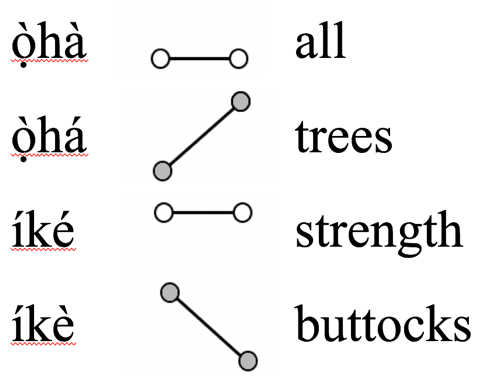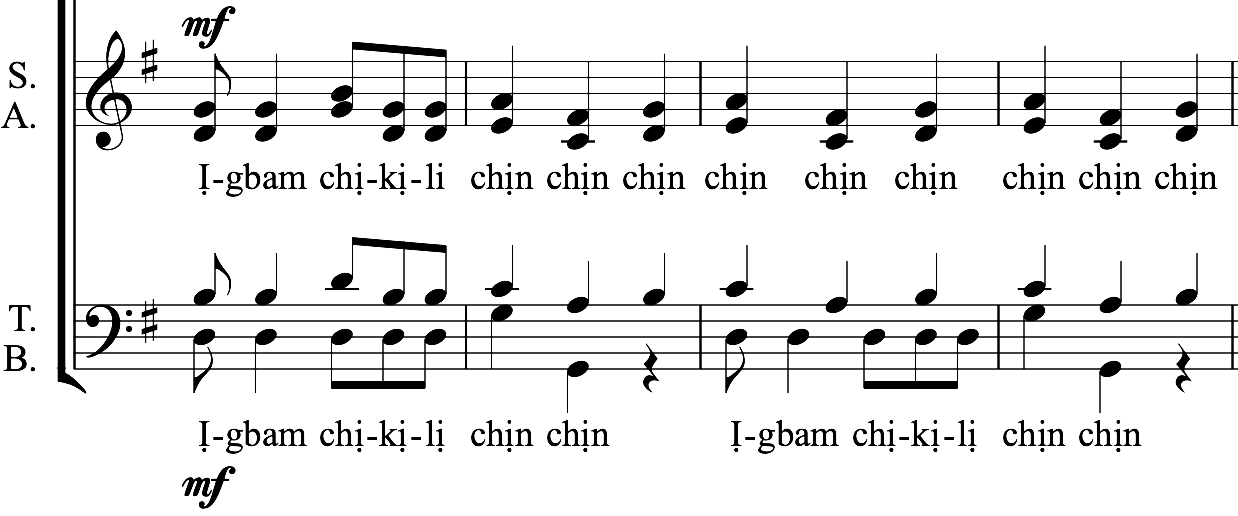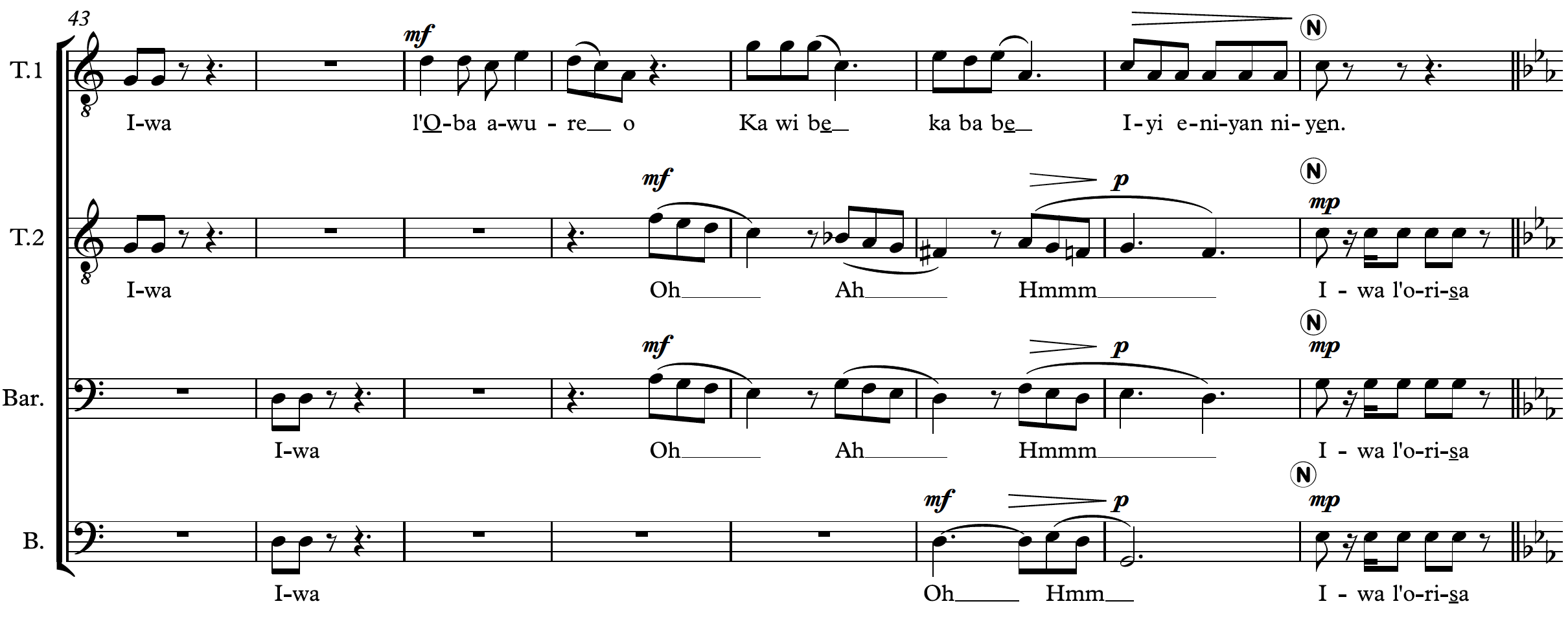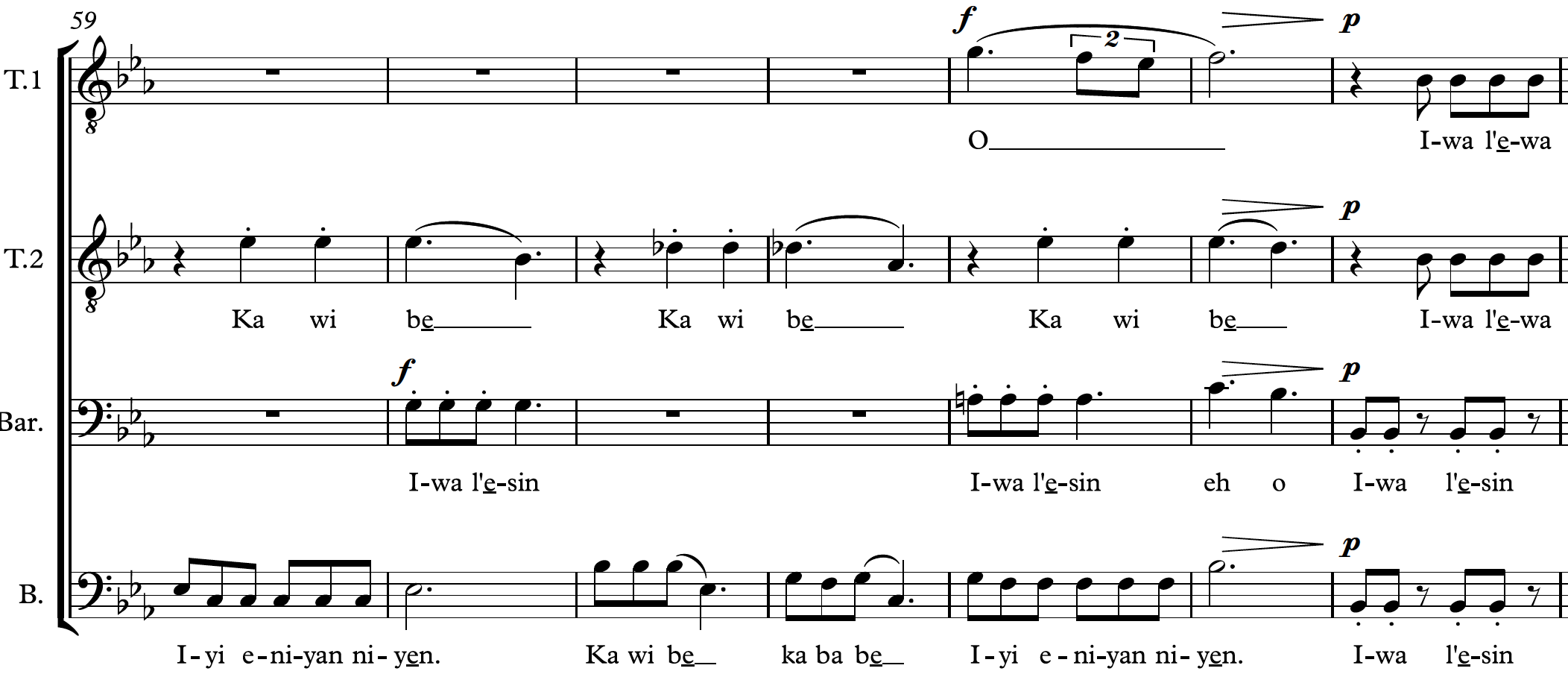Introduction
Like the spoken word, song lies at the heart of African musical expression and imagining. Without language, there would be no song; without song, African music would not exist. Language and music are thus tied, as if by an umbilical cord. No one who ignores its linguistic aspects can hope to reach a profound understanding of African music.
In his 2015 keynote address to the Society for Music Theory, "Rethinking Music Theory with African Aid," Kofi Agawu identified the relationship between music and language as an important avenue for future research. This relationship is key to developing an understanding of African music, in contrast to our students' more common experiences of ostensibly "African" music, such as freestyle jamming in a djembe drum circle (Olatunji et al. 2005, Hess 2015, Carter-Ényì, Carter-Ényì & Hylton 2019).
Musical analogies have been heuristics for understanding and learning tone languages such as Yorùbá since the 19th century (Carter-Ényì 2018). Likewise, language is a source for understanding the features of African melody (Ekwueme 1974), which has shaped popular music throughout the era of globalization (Carter-Ényì & Carter-Ényì 2020).
This tongue twister in the Ìgbò language of southeastern Nigeria juxtaposes different meanings of a single homophone. "Akwa" may mean cloth, cry, egg, or bed, depending on the overall pitch height and trajectory from one syllable to the next.
Ìgbò
Nwányī n'ákw'ákwà,
ì n'àkw'ákwā
n'òkúkò yìr'àkwá,
n'énú ákwà í kwàr'àkwá,
nọ́ n'énú àkwà?
English
Woman sewing cloth,
are you crying
because a hen laid an egg,
on cloth you've already sewn,
which is on top of the bed?
Listen to the audio here: http://hdl.handle.net/20.500.12322/adept.ibo:0004.
The four different [akwa] glosses are:
- Ákwà (HL) cloth
- Ákwá (HH) cry
- Àkwá (LH) egg
- Àkwà (LL) bed
An acute accent (´) indicates a high tone, and a grave accent (`) indicates a low tone. Note that ákwá (HH, cry) and àkwà (LL, bed) have the same trajectory (no change in tone height), but they may still be distinguished based on their relative pitch to other words spoken before or after.
This essay explores text-setting in two Nigerian tone languages through composition and re-composition exercises. The topic of singing and text setting in Nigerian tone languages has been written about for over a century, notably by composers including Phillips (1953), Ekwueme (1974), Euba (2001), Onyeji (2005), and Olúrántí (2012). These writings address a professional audience, usually in composition or music research. This essay summarizes basic concepts of the topic for undergraduate music theory teachers and their students.
While the influence of speech tone on melodies in Ìgbò and Yorùbá is well established, speech tone does not have as great a functional load in all languages of sub-Saharan Africa. Many Nigerian composers also compose in English, an official language of Nigeria, a former British colony. Writing music based on indigenous language texts remains an essential aspect of maintaining artistic and cultural continuity with pre-colonial musical traditions.
Teaching Text Setting in Ìgbò and Yorùbá in Western Classrooms
To broadly understand text setting in Ìgbò and Yorùbá, exercises are provided for students to correct a mis-setting of a translated hymn and then to compose a new melody to reflect the contour of the speech tones. After addressing monophonic melodic contour, there are exercises for part-writing. True competence in composing melody and harmony for tone language lyrics requires fluency in the language. However, theoretical exercises may be introduced at various stages in the standard theory curriculum or as special topics that (1) greatly expand student awareness of the world's cultures—at least 60% of living languages are tonal (Yip 2002)—and (2) challenge students to apply theoretical knowledge of core topics, such as melodic shape and part-writing, in new ways.
Exercise 1: Recomposition of a Mis-Setting, Part I
Hymn translations from the colonial era demonstrate the importance of tone in Niger-Congo languages. A well-known translation of the lyric "All hail the pow'r of Jesus' name" into Ìgbò preserves the number of syllables (eight) but also introduces a pitch contour: "Ọ̀hà kèlé íké Jésù" (é has a high tone and è has a low tone). Singing this text to the usual hymn tune "Coronation" by Oliver Holden distorts the tones on the first word and the third word. In Figure 1, red indicates a mismatch between speech tones and melody, which could cause another word to be heard. Yellow indicates a missetting that cannot cause another word to be heard. There is only one word spelled /jesu/, whereas multiple words are spelled /ike/.
The correct lexical tone for "Ọ̀hà kèlé íké Jésù" is low-low, low-high, high-high, high-low. The melody in Figure 1 makes the lyrics sound like "Trees hail the buttocks of Jesus" instead of "All hail the strength of Jesus."
| Ìgbò minimal pairs /oha/ and /ike/ | Tone pattern: (´) high and (`) low | Ternary Contour | Meaning |
|---|---|---|---|
| ọ̀hà | low-low | 0 | all |
| ọ̀há | low-high | + | trees |
| íké | high-high | 0 | strength |
| íkè | high-low | – | buttocks |
Today, any fluent Ìgbò speaker familiar with Christian doctrine knows this is an error in translation. However, Nigerian composers still use the minimal pair /ike/ to illustrate why sensitivity to tone is vital for musical settings.
Activity
Students may correct the mis-setting of "Oha Kele Ike Jesu" using the fewest possible note changes. Depending on the curricular context, instructors may ask students to make corrections that preserve the original hymn tune's harmonic implications. If teaching within a tonal harmony context, it is crucial to preserve chord tones that support the tonic chord (I) on the first downbeat and dominant chord (V) on the last note of the phrase.
The mis-setting may be corrected while preserving the harmonic movement from I to V by replacing three notes:
- replace the first note, D4, with G4
- replace the sixth note, A4, with B4
- replace the seventh note, G4, with B4
Exercise 2: Recomposition of a Mis-Setting, Part II
The re-composition in Figure 4 has only three notes and considerable repetition. In combination with the rhythmic monotony (all quarter notes), the melody is relatively uninteresting. A Nigerian melody for "Ọ̀hà kèlé íkè Jésù" is known in the contemporary oral tradition:

Figure 5: "Ọ̀hà kèlé íkè Jésù" chorus setting (commonly sung in churches in southern Nigeria) (Author's transcription). Recording: http://hdl.handle.net/20.500.12322/adept.ibo:0003.001
The melody in Figure 5 indicates some flexibility in the setting of tones between words. Note that "-hà" and "kè-" are both low tone but set to different pitches. Likewise, "Jé-" is lower than "ké-" though both are high tones. However, the directional relationships within words are preserved, so "kèlé" is a rising skip, "Jésù" is a falling step, and both "ọ̀hà" and "íké" are repeated pitches. The preservation of directional relationships within words is critical, especially where homophones may be confused, like /ọha/ or /ike/. Each syllable's precise pitch is flexible, but it is important to avoid setting high tones below low tones in close proximity.
Unlike pitch, the setting's rhythm cannot change word identity, but the long and short notes in Figure 5 likely correspond to speech rhythm to some extent. The shortest notes are eighth notes, and the longest notes are quarter notes. All the words are two syllables long, and the second syllable is generally longer than the first syllable. Also, the "ọ-" of /ọha/ and the "-le" of /kele/ are on the downbeat. More importantly, the alternation of 6/8 in the first bar (two equal divisions of the measure into dotted eighths) with 3/4 grouping in the second bar (three equal divisions of the measure into quarter notes) is a standard metric characteristic of Ìgbò music specifically.
Activity
Given the new knowledge that interval directions within words are more important than those between words, instructors may ask students to compose a new melody for the text. While it is possible to set this text correctly using any scale, the Major pentatonic scale (do-re-mi-so-la) is a good option. Encourage students to introduce rhythmic variation, in contrast to the hymn's all-quarter-note rhythm (Figure 1). Remind students of the following:
- If there is no change in the tone between syllables of a word, as in Íké (high-high) and Òhà (low-low), the pitch should be repeated.
- If there is a change in tone between syllables of a word, as in Kèlé (low-high), which rises or Jésù (high-low) which falls, the melodic interval should reflect the rise or fall of the speech tone.
- Ideally, high and low tones should be spread apart vertically within the phrase's range. The majority of low tones in Figure 5 are on E4, a significantly lower pitch than B4, on which most high tones are set. A low tone (kè-) is set above a high tone (Jé-), but they are not close together.
- Finally, take inspiration from the metric and rhythmic variety in the oral tradition tune (Figure 5). While not all Ìgbò music alternates between 6/8 and 3/4, very little follows a strict quarter note repetition like the Coronation hymn tune.
The setting in Figure 6 follows the rubric provided. Note that the melody does not represent other aspects of Ìgbò music, which may not be expected from students at this stage.
Interlude: On Harmony and Part-Writing in a Global Context
Once students understand that melodic contour is implied by the text, instructors may address the topic of harmony. As soon as this issue is raised, some astute pupils may recognize that: if the melodic voice carefully represents the contours of speech tones, so should the harmonic voices. Moreover, if it is a homophonic texture, this will require consistent parallel and similar motion! As taught in European-modeled conservatories, part-writing favors contrary motion to yield melodic independence of harmonic voices, and many other rules (e.g., prohibiting direct and parallel fifths) correlate with this aesthetic. The antithesis, a preference for parallel and similar motion, goes against much of what we teach for part-writing.
The notion that voice-leading principles associated with Western common-practice music are essential for tonal harmony is a Eurocentric perspective. Furthermore, oblique and contrary motion are not compatible with vocal harmonization in tone languages (which, again, are found in 60% of the world's cultures, Yip 2002). As we develop inclusive curricula, we will find that many of the preference rules for European common-practice music do not characterize all practices of tonality. Instructors are encouraged to engage students in discussing the varieties of tonal harmony that exist, sharing observations about popular music and non-Western music.
Exercise 3: Part-Writing for Tone Languages, Part I: Phillips' Homophony
Ekundayo Phillips, a British-educated organist and composer from Lagos, described techniques for composing for the Yorùbá language of southwestern Nigeria in 1953. Phillips proposed that Yorùbá melody should: reflect the contour of texts; be syllabic, not melismatic; and use pentatonic scales. Phillips argued that harmony (in the homophonic sense) should use predominantly parallel and similar motion and avoid cadential semitones (i.e., ti-do and fa-mi). While Phillips is far from the last word in Nigerian composition, his influential method yields a result that is recognizable as Yorùbá church music, partly because of the popularity of his compositions.
Students will need a clear understanding of parallel, similar, oblique and contrary motion. The fundamental concept in Phillips' treatise is to use parallel and similar motion, for which the tritone resolution of V7–I cadences is at odds. If one uses a Major pentatonic scale, as Phillips suggests, this excludes ti and fa.
Activity
While Phillips focused his composition on Christian texts, more recently, Yorùbá composers such as Euba and Olúrántí have drawn on indigenous sources such as Yorùbá proverbs (owé). An example is Olúrántí's 2019 composition Ọmọlúàbí. The composer explains Ọmọlúàbí as "a socio-cultural philosophy of the Yorùbás that describes a person of good and excellent character." The following Yorùbá proverb is an example of an indigenous text used in Olúrántí's compositions. The three staff lines in Figure 7 represent speech tones (low, mid, and high), not notes.
Ká wí bẹ́-ẹ̀, ká bá bẹ́-ẹ̀, iyì ènìyàn nìyẹn.
A man is honorable when his word is his bond.
Tone Sequence: HHHL, HHHL, MLLLLLM (H=High; M=Mid; L=Low)
Students may compose a melody for the proverb by realizing the speech contour (represented above) with unspecified pitches into a melody with specific notes. To follow Phillips' recommendations, one may use the pentatonic scale or the major scale while avoiding fa-mi or ti-do at cadential points.
Once the melody is complete, compose a homophonic harmonic voice to accompany it, following a similar melodic contour. Note that using parallel or similar motion is unnecessary where there is a comma or period in the text. There is a reset in the intonational contour after breaths and pauses even in speech.
Evaluate whether the result is singable by typical vocal or choral standards (e.g., a tessitura equal to or less than an octave for each part). Using a pentatonic scale is common in African melody, and along with the need for falls and rises that represent speech tones, may lead to a highly angular melody that goes against Western aesthetics of melodic fluency (Carter-Enyi and Carter-Enyi 2020).
Another question to consider in discussing resulting settings is whether students felt it was necessary to repeat the note for like tones (e.g., MMM) or may be made steps for these repetitions, especially across word boundaries as in the popular melody for the Ìgbò text (see Figure 5).
Exercise 4: Part-Writing for Tone Languages, Part II: Ekwueme's Polyphony
In 1974, Lazarus Ekwueme elaborated significantly on polyphonic writing for tone languages. He offered alternatives to homophony with parallel and similar harmony. First of all, staggering text (so that different vocal parts enter with the same text at different time points) avoids the necessity of parallel and similar motion. Vocal imitation of text corresponds to the common oral and improvisatory style of call and response (antiphony) as in Figure 10, but could also be part of a denser polyphonic texture with overlapping imitation.
Other setting alternatives offered by Ekwueme include using alliterative sounds (vocables) in subordinate voices if one wishes to have more flexibility with melodic contour. In "Ote Nkwu" (1992), Ekwueme uses the onomatopoeic phrase "Igbam Chikili Chin Chin Chin" to represent the tapping of the tree to release palm wine (nkwu). Because there are no lexical speech tones present, he can more freely set the text using oblique and even contrary motion (see Figure 11).
Although Ekwueme (1974) refers specifically to Ìgbò, many of these practices were being used by composers throughout Nigeria at the time.
Activity
Students may recycle melodic settings from Exercise 3 to incorporate these alternatives for polyphonic accompaniment. An easy option for adding a contrapuntal line is to use the vocable "o," common in Yorùbá singing. For a greater challenge, one may include some close imitation of the text, as shown in Figure 12.
At this point, a wide variety of model compositions may result. A possible point of discussion is why transposition is an appropriate transformation of the melody, but inversion or retrograde may not be. In fact, in Yorùbá speech, a form of transposition and range expansion of tone levels occurs as a speaker's energy levels change. Furthermore, different speakers (particularly children, women, and men) have different ranges. In other words, tone levels are not fixed and may adapt within speech and to a wide variety of musical settings of the same words in the same piece of music. The variety of settings produced by students will illustrate this point.
Conclusion
These exercises may be integrated at different points in an existing conventional theory sequence or be a unit unto themselves. Adding such exercises outlined here will be daunting in a curriculum already crowded with topics typically taught in Euro-centric conservatoires. However, in a curriculum that emphasizes model composition exercises, incorporating these exercises will challenge students to apply knowledge of melody and part-writing to new cultural frameworks that are in some ways compatible with tonal harmony but also have some necessarily distinct practices. Providing activities that require students to adapt their knowledge and skills is a valuable learning outcome. While students may never visit Nigeria or other parts of West Africa, musical practices from this region have much to offer to music students from the United States. Furthermore, developing an adaptable knowledge of music theory that includes the composition exercises from West Africa will contribute to their training, serve them professionally, and prepare them for a wide range of careers involving music.
Bibliography
- Agawu, Kofi. 2016. The African Imagination in Music. New York: Oxford University Press. https://doi.org/10.1093/acprof:oso/9780190263201.001.0001
- Carter-Enyi, Aaron, and Quintina Carter-Enyi. "Oha kele ike Jesu (Igbo Sacred Song)." Africana Digital Ethnography Project: Igbo Collection, no. 3 (2013). http://hdl.handle.net/20.500.12322/adept.ibo:0003.001
- Carter-Enyi, Aaron. 2018. "Hooked on Sol-Fa: The Do-Re-Mi Heuristic for Yorùbá Speech Tones." Africa 88 (2):267-290. https://doi.org/10.1017/S0001972017000912
- Carter-Enyi, Aaron, and Quintina Carter-Enyi. 2020. ""Bold and Ragged": A Cross-Cultural Case for the Aesthetics of Melodic Angularity." Music & Science Vol. 3:1-15/ https://doi.org/10.1177/2059204320949065
- Carter-Enyi, Quintina, and Aaron Carter-Enyi. 2017. "Nwanyi n'akw'akwa: Igbo Tongue Twister." Africana Digital Ethnography Project: Igbo Collection, no. 4 http://hdl.handle.net/20.500.12322/adept.ibo:0004
- Carter-Enyi, Quintina, Aaron Carter-Enyi, and Kevin Nathaniel Hylton. 2019. "How we got into Drum Circles, and how to get out: De-essentializing African Music." Intersections: Canadian Journal of Music 39(1):73-92. https://doi.org/10.7202/1075343ar
- Ekwueme, Laz E. N. 1974. "Linguistic Determinants of Some Igbo Musical Properties." Journal of African Studies 1 (3):335-353.
- Euba, Akin. 2001. "Text Setting in African Composition." Research in African Literatures 32 (2):119-132. https://doi.org/10.1353/ral.2001.0047
- Hess, Juliet. 2015. "Decolonizing music education: Moving beyond tokenism." International Journal of Music Education 33(3): 336-347. https://doi.org/10.1177/0255761415581283
- Olatunji, Babatunde, Joan Baez, and Robert Atkinson. 2005. The beat of my drum: An autobiography. Temple University Press.
- Oluranti, Stephen. 2012. Polyrhythm as an Integral Feature of African Pianism: Analysis of Piano Works by Akin Euba, Gyorgy Ligeti & Joshua Uzoigwe and Àjùlo Kìnìún (Original Composition). http://d-scholarship.pitt.edu/id/eprint/11866
- Onyeji, Christian. "Research-composition: A proposition for the teaching of composition from the traditional perspective." Emerging Solutions for Musical Arts Education in Africa (2005): 250–66.
- Phillips, Thomas Ekundayo. 1953. Yoruba Music (African): Fusion of Speech and Music. Roodepoort: African Music Society.
- Yip, M. 2002. Tone. Cambridge: Cambridge University Press. https://doi.org/10.1017/CBO9781139164559
Erratum
2/18/2022: Removed incorrect list of peer reviewers and replaced with correct peer reviewers: Juan Diego Diaz, Brian Moseley, Keith Salley.














